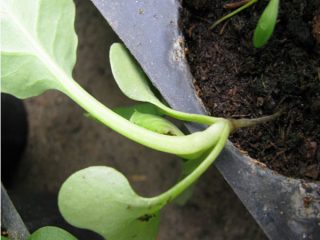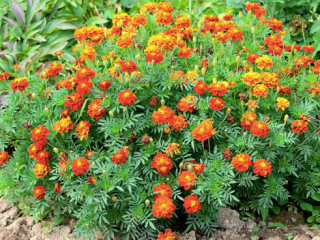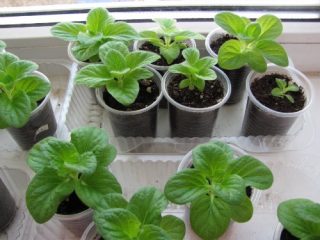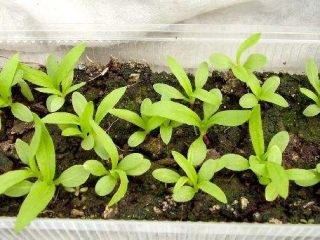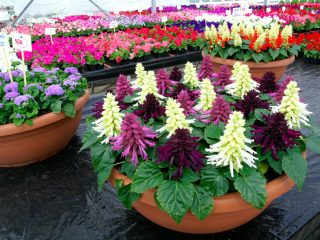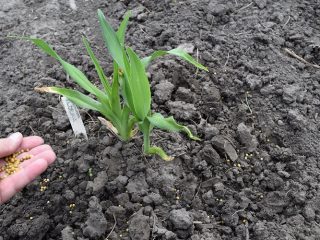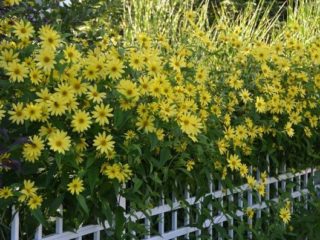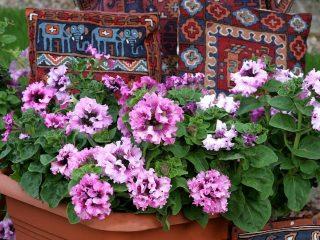Content
Annual small petal, also called erigeron, looks like a chamomile with small thin petals. In fact, the flower is very common both in the wild and as a garden and ornamental crop. It is highly popular among plant growers not only for its simple appearance, but also for its medicinal properties.
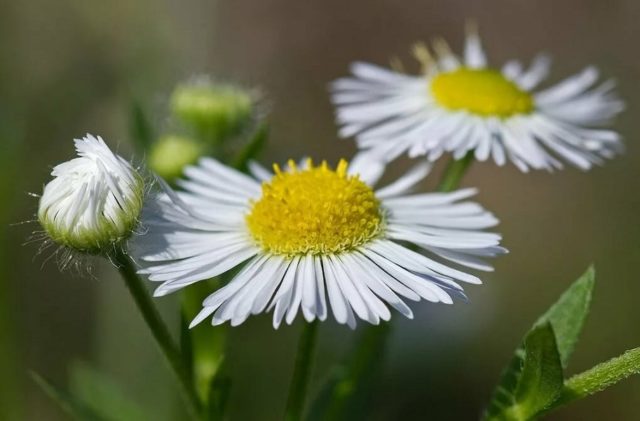
For medical purposes, only the above-ground part of the plant is used; it is collected during the flowering period.
Description and characteristics
The annual small petal (erigeron annuus) is an invasive species from North America. It was brought to Europe in the 17th century and until the mid-20th century it was widespread as a garden and ornamental crop. Afterwards it began to be found in the wild. Today, annual small petal is widespread everywhere, especially in the central regions of Russia, and is mostly considered a weed.
Belongs to the Aster family (Asteraceae). A herbaceous plant whose bush reaches about 100 cm in height. It is worth noting that the climatic conditions of Russia are much more suitable for the annual small petal than in its homeland, so you can find specimens growing up to 150 cm in height.
The shoot is erect, branched closer to the top. It has a bristly-lowering surface in the lower part, and a spiny-bristly surface in the upper part. The leaf blades vary in shape from oval to oblong-lanceolate. Towards the top of the shoot they gradually decrease in size. The basal leaves are the largest, reaching a length of 4 to 17 cm and a width of up to 4 cm. Their base is wedge-shaped, and the edges are coarsely toothed with a sharp or slightly rounded apex. Stem leaves are petiolate, from 2 to 9 cm in length. The uppermost ones are sessile, with smooth or irregularly jagged edges and a sharp end.
The inflorescence is loose, paniculate or corymbose, up to 0.8 cm long and up to 1.5 cm in diameter. The baskets are numerous, from 5 to 50 pieces. The involucre of green, pubescent leaves is hemispherical, two- or three-rowed, with the outer leaves being shorter than the inner ones. Flowers are false-ligulate, 80-125 pcs. in a basket, arranged in 2 rows. The marginal flowers are white or pale blue, and the tubular flowers of the disc are yellow in color.
At the end of flowering, achenes appear, small in size (0.8-1.2 mm), lanceolate in shape. Reed flowers have a single-row pappus, the rest have a two-row pappus, with the pappus 2-2.5 times larger than the achenes themselves.
Chemical composition
Annual small petal is a plant that has been used in folk medicine since the 18th century, and all thanks to its medicinal properties due to its rich chemical composition.
The entire above-ground part of erigeron contains a large amount of essential oils (0.3-0.6%), containing a-limonene, terpenoids and aldehydes. These substances give the plant not only an unusual lemon aroma, but also make it an excellent anti-inflammatory agent. In addition, substances such as:
- tannin;
- flavonoids;
- choline;
- resins;
- tannins;
- ascorbic acid;
- mineral salts.
Medicinal properties of small petal annual
The annual small petal itself, despite the fact that from the photo it looks like a rather simple and unremarkable plant, is considered in folk medicine to be an excellent assistant in the treatment of many diseases.
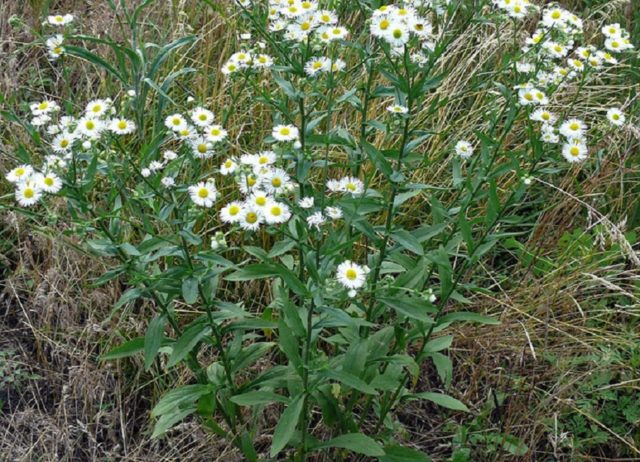
The main feature of annual small petal is that it is not addictive with long-term use
The composition, rich in microelements, makes it possible to use this plant as a natural anti-inflammatory agent. And the content of tannin and flavonoids in it promotes the removal of uric acid, which is an undeniable advantage in the treatment of gout.
It is also worth noting that the plant has a hemostatic effect, so it is recommended to take it for hemorrhoidal and uterine bleeding. And poultices can reduce or completely prevent pain.
The tannins contained in the annual small petal make it a good remedy for diarrhea.
The antiseptic and analgesic properties of erigeron help with sore throat.The use of the plant against hair loss has also been noted.
Methods of application
In folk medicine, flowers, leaves and young stems of the annual small petal are used. They are used in a variety of variations, in the form of an infusion or decoction, and also as a lotion or poultice.
Infusion
An infusion of small-petaled annual is used to relieve pain. It is prepared as follows:
- Take 20 g of dried erigeron herb and pour it into a liter glass jar.
- Fill it with 1 liter of hot water.
- Leave for 10-15 minutes.
Decoction
For decoction, dried stems of annual small petal are often used. The preparation scheme is similar to obtaining an infusion:
- 1 tsp. dried erigeron herb with a slide is poured into a half-liter jar.
- Fill it with ¼ liter of boiling water.
- Let the broth brew until it cools completely.
Tea
In addition to the small-petalled annual plant, other plants are also used to prepare medicinal tea. For example, for a drink that helps alleviate cystitis and urethritis, you should prepare a mixture of equal amounts of erigeron, hibiscus, goldenrod and birch leaves. After 1 tbsp. l. Brew the resulting mixture in 1 liter of boiling water. It is recommended to drink no more than 3 glasses of this tea per day.
You can also prepare a medicinal drink to cleanse the body and remove toxins. In this case, annual small petal, meadowsweet and goldenrod are mixed in equal quantities. 1 tsp. The resulting mixture is brewed in 250 ml of boiling water. You can drink 2 glasses of tea a day.
Oil
Small petal oil is used as a hemostatic agent mainly for uterine bleeding. To do this, take 5-10 drops orally, repeat the procedure if necessary.
Tincture
An alcohol tincture of small petal annua is an excellent remedy for the treatment of arthritis. Before use, it must be diluted with water.
Use in folk medicine
Small petal annual is used in folk medicine in the treatment of a variety of diseases. But at the same time, it is important to observe the correct preparation, the ratio of components and the method of using this or that product, be it an infusion, decoction or tea.
For the treatment of rheumatism
For rheumatism, it is recommended to take an infusion (tea). For this:
- 20 g of dried small petal herb are brewed with 1 liter of boiling water.
- Leave the product for 15 minutes, then filter.
- Drink the resulting drink 1 glass 3 times a day after meals.
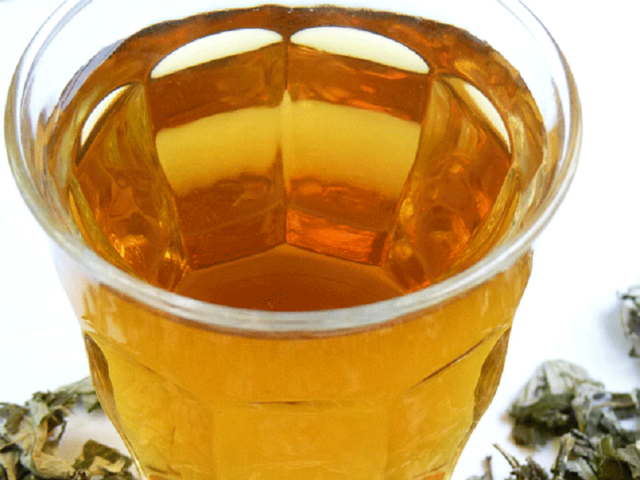
The course of treatment with a herbal remedy is 3 weeks
For alcohol intoxication
A collection mixed from the flowers and grass of small-petalled annua (10 g each), the same amount of St. John's wort, sage and horse sorrel seeds is recommended for use in cases of alcohol intoxication. In this case, adhere to the following actions:
- 2 tbsp. l. collection, pour 500 ml of boiling water and place everything in a water bath.
- Stirring, boil the mixture for 2 minutes.
- After covering with a cloth, infuse the broth for another 30 minutes.
- The finished drink should be taken every hour, 50 ml until the signs of alcohol poisoning completely disappear.
For endometriosis
It is also recommended to use an infusion of the following herbal collection as a therapeutic agent for endometriosis:
- A mixture of annual petal, lemon balm, yarrow, meadowsweet, lavender, wormwood and calendula is prepared in equal quantities.
- 4 tsp. collection is poured with boiling water (1 l).
- Cover with a lid and leave for 1 hour.
This infusion is taken for 3 weeks, 50 ml 3 times a day.
For toothache
To eliminate toothache, it is recommended to use freshly harvested shoots of erigeron. In this case, a couple of branches of the plant are steamed with boiling water for no more than 2-3 minutes, then the product is allowed to cool. Soak cotton wool or a small piece of gauze folded in several layers in it and apply it to the diseased tooth. Leave the lotion until the pain subsides.
For intestinal disorders
For diarrhea and intestinal disorders, strong tea made from the grass of the small petal annua helps well. The infusion itself is prepared and taken according to the following scheme:
- 1 tsp. dried erigeron is poured into 250 ml of boiling water.
- Infuse the product for 10 minutes, then filter.
- They drink tea throughout the day in small sips.
For arthritis
The most effective remedy for the treatment of arthritis is an alcohol tincture of small petal annua. It helps reduce joint pain and also stop inflammatory processes.
To prepare the product, use 30 drops of alcohol tincture per 1 liter of boiled warm water.
To cleanse the body and remove toxins
Tea based on annual small petals, in addition to insecticidal properties, also has a diuretic effect, which helps remove waste and toxins from the body. Therefore, it is often taken as a cleanser.
Tea is prepared from the collection of erigeron, goldenrod and meadowsweet by brewing with boiling water.
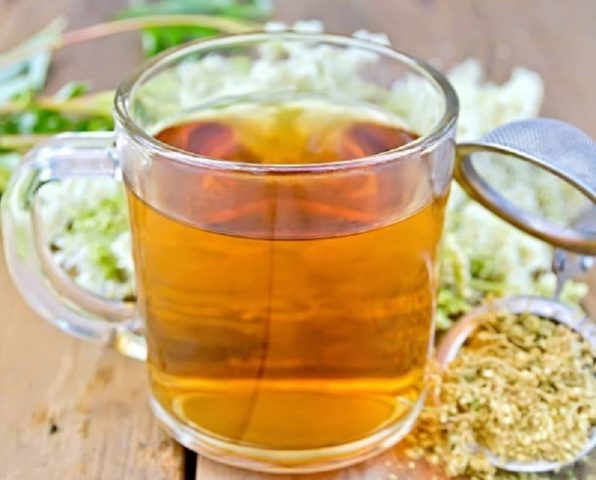
It is recommended to drink no more than 2 glasses of herbal tea per day.
Against hair loss and strengthens hair
In addition to traditional medicine, annual small petals are also used in cosmetology. A decoction of erigeron helps well if used against hair loss and to strengthen and accelerate hair growth. The product itself is prepared as follows:
- 30 g of small petal herb is poured with hot water.
- Place the resulting mixture in a water bath and boil for 15 minutes.
- Remove the decoction and leave for another 2 hours.
- Then filter and rinse your hair with it after washing.
Contraindications
Despite the impressive chemical composition of the annual small petal, this plant is not toxic and does not cause addiction. Erigeron is not able to accumulate harmful substances, therefore it is relatively safe for humans. But before using any product based on it, you should definitely consult with your doctor, as an allergic reaction may occur. Contraindications also include individual intolerance and pregnancy.
Collection and preparation
Collection of annual small petals for medicinal purposes can be carried out throughout the entire growing season (from June to September). But the most favorable time for harvesting raw materials is still considered to be the period when flowering begins. It falls around the end of June and beginning of July.
If the bush of the plant is tall enough, then only the tops of the shoots should be cut off, without affecting the rough part of the stems.
After collection, the cut shoots are distributed into bundles of the same size and tied with thread.Hang the collected plants to dry in a place protected from direct sunlight, preferably under a canopy. This is necessary to maximize the preservation of all the beneficial qualities of erigeron.
Since the herbaceous part and small petal flowers are often used separately for medicinal purposes, after complete drying it is recommended to separate the buds from the stems and place them in different containers.
The shelf life of dried raw materials in a cardboard box is no more than 1 year. Afterwards the plant begins to lose its medicinal qualities.
Conclusion
Annual small petal is a very unremarkable plant, but its rich chemical composition makes it a good healing agent. Naturally, the herbal mixture should be used for medical purposes only after consultation with a specialist. It is also better to use it as an auxiliary rather than a primary medicine.
